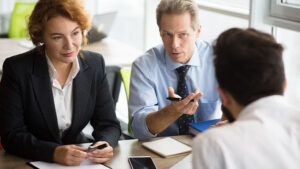Sometimes, nothing feels more difficult than getting a project started when you’re staring at a blank screen or blank piece of paper, but luckily, project management tools help provide structure to blank slates. However, there are tons of project management tools out there that simply don’t work. Project management is a critical skill in the workforce and is even its own industry. In the US, there are over 420,000 project managers (PMs), and they employ a variety of different project management tools and techniques.
Why You Need Project Management Techniques
Project management is defined as the application of knowledge, tools, and techniques to meet project deadlines. There are six constraints of project management: scope, time, quality, cost, risk, and resources. When selecting a project management technique, PMs must closely consider each constraint.
Project management is mission-critical to a business’s success, but over 44 percent of PMs don’t use project management software. 9.9 percent of every business’s dollar is squandered due to poor project performance, but utilizing the right project management tools and techniques could drastically improve productivity, efficiency, and project success. 77 percent of high-performing PMs utilize project management tools and techniques, and each person undoubtedly has their favorite ones. In this article, we’ll share a breakdown of classic and Agile methodologies, what they’re used for, the pros and cons of each, and how you can become a certified project manager.
Classic Project Management Techniques and Tools
Classic or traditional project management tools have been used for decades and are popular in large organizations worldwide. They typically follow a sequential pattern, emphasizing linear processes like pre-planning and budgeting, outlining clearly defined objectives, and transparent documentation and accountability. These project management techniques heavily rely on a clearly defined scope to guide the project, as this breaks down the entire project before it even starts. Also, the PM typically takes control of the project from start to finish, adjusting as needed and only keeping team members informed when necessary.
Also Read: Understanding Scope in Project Management: Definition and Importance
#1. Waterfall Methodology
One of the most well-known project management approaches is the waterfall method. The waterfall method is a classic PMP technique in which a project does not move forward until the previous step is complete. Like most classic techniques, it is linear and sequential, with each phase building on the previous one. In contrast, the Agile project management method encourages working on multiple phases simultaneously. The waterfall project management method is perfect for clearly defined, structured projects that aren’t likely to change, such as some software development.
Pros
- Clear structure
- Defined objectives and goals
- Accurate cost estimation
Cons
- Can feel restrictive
- Often discourages outside feedback from the end user or client
- Difficult to change the scope
#2. Gantt Charts
Gantt charts are another type of visual project management tool that helps teams see dependencies. Larger tasks are broken up into chunks, and the smaller tasks are scheduled on the Gantt timeline. Gantt charts are often used in waterfall methodologies as you can visually see the “cascade” of dependencies between tasks.
Pros
- Visual
- Typically best for large projects
Cons
- Not easy to see all tasks at once
- Set-up can be time-consuming
#3. The Critical Path Method
The Critical Path Method (CPM) is an algorithm that estimates the longest stretch of project activities. To establish the critical path, you measure how long it would take to do each activity, and then the longest period is the critical path. For example, when building a house, there are hundreds of tasks, but putting a roof on might take the longest. Installing windows, painting, or laying down flooring might take a significantly shorter amount of time. Therefore, a PM could accurately schedule out the critical part, ensuring the home build stays on time and on budget with this project management technique.
Pros
- Easy task prioritization
- Accuracy in scheduling
- Increased budget adherence
Cons
- Might not be suitable for all projects
- Can be a complex calculation
#4. The Critical Chain Method
Somewhat similar to CPM, the Critical Chain Method (CCM) is a project management method used when project resources are restricted. It modifies the schedule to account for these limited resources and adds duration buffers. For example, maybe a software developer is going on vacation during a major project; CCM would re-allocate resources during that time.
Pros
- Builds on Critical Path Method to accommodate even more restricted resources
- Accurate scheduling and forecasting
Cons
- Doesn’t work well with small projects
- Hard to determine potential issues on non-critical tasks
- Difficult to implement
#5. Work Breakdown Structure
Work Breakdown Structure (WBS) is a visual, hierarchical project management method that breaks a process down into smaller components. It breaks down key work and deliverables into more manageable chunks.
Pros
- Visual
- Detailed steps
- Transparency and accountability between team members
- Good for allocating budget, time, and resources
Cons
- Many tasks at once
- Can become outdated quickly
- Requires significant active management
Also Read: Top 12 Project Management Books You Should Check Out
Agile Project Management Tools and Techniques
In contrast to classic project management techniques and tools, Agile PMP tools and techniques involve all parties of the project. From clients to individual contributors to the PM themself, everything is laid out and highly transparent. Agile projects often have a flexible or changing scope, and the entire project might not be laid out from start to finish like in traditional methodologies. Agile techniques require collaboration, flexibility, and continuous feedback and often work better in more lean projects. 59 percent of PMs are running two to five projects at a time, and Agile processes can help them stay adaptable to ever-changing needs.
Roughly 70 percent of US companies use Agile tools and are often more successful. Agile projects have a 64 percent success rate, whereas the waterfall method only has a 49 percent success rate. Scrum is the most popular Agile process, with 61 percent of survey respondents using it in research and development, production and operations, customer service and support, and marketing.
Agile method methodology is known for breaking up significant projects into smaller pieces, making it easier to manage and encouraging continuous collaboration. Teams cycle through a constant feedback loop of planning, executing, and evaluating.
#6. Scrum
One of the most popular project management methods, Scrum is an agile framework that helps teams generate value through an interactive process. Most commonly referred to in software development, Scrum takes a fast, collaborative, and flexible approach to deliver the most value for the customer. Scrum also contains five values: commitment, courage, focus, openness, and respect. These help teams work towards a common goal in a fast environment.
Pros
- Sprints help break down large projects
- Team-oriented
- Great for fast-moving projects
- Steps such as development and testing happen simultaneously
- Low cost
Cons
- Challenging for inexperienced or large teams
- All team members have to be invested
- Often leads to scope creep
#7. Kanban Boards
Kanban is a visual scheduling system based on the Japanese word that roughly means “card you can see.” This agile process utilizes cards to track work as it moves from planning to completion. It’s highly transparent; all team members can visually see card status for themselves, and Kanban is often used in manufacturing settings. On smaller scales, Kanban boards are used in many project management software like Asana or Trello.
To compare Kanban to Scrum, Kanban is based on Lean values thanks to its creation in Toyota manufacturing. Kanban does not have predetermined roles like in Scrum, and team members aren’t responsible for estimating the time it takes to complete tasks.
Pros
- Highly visual
- Transparent
- Flexible
- The goal is to limit work in progress so that team members can stay focused
- Bottlenecks are quickly revealed
Cons
- Better suited for repetitive tasks
Also Read: Essential Project Management Skills to Learn
#8. Extreme Programming
Extreme Programming (EP) is highly specific to software development and works towards a high-quality finished product and better quality of life for engineers. It focuses on small, incremental deliverables instead of large segments (like the waterfall method, for example) and operates with five key values: communication, simplicity, feedback, courage, and respect.
Pros
- Pair programming helps reduce errors
- Incremental releases create a more stable product
Cons
- High cost to implement
- Requires significant version management
#9. Adaptive Project Framework
Adaptive Project Framework (APF) is a PMP technique known for its adaptability when it comes to unforeseen circumstances in a project. Teams establish flexible plans and can quickly adjust them when conditions change. Its core principle is often referred to as “learning by doing,” and it allows for a systematic approach to improving decisions. APF is ideal for a project that doesn’t necessarily have a clear end state in mind.
Pros
- Flexible
- Fast review cycles
- Bolsters client satisfaction
Cons
- Can feel chaotic when there’s too much change
- Scope creep
Organizations that undervalue project management have 50 percent more of their projects fail. Luckily, 97 percent of organizations believe project management is critical to business success. When PMs or another role use classic or Agile methodologies, they work with tried and tested techniques. Depending on the project, budget, team size, goals, and more, effective project managers know when to switch up PMP tools and techniques.
Learn More About Project Management Tools and Techniques That Actually Work
Project managers with a PMP certification earn roughly 20 percent more than non-certified PMs, making certifications an effective way to enhance your career and help you earn more money.
A post graduate program in PMP management allows you to become a digital-age project leader with tons of project management tools and techniques at your fingertips. In this project management certification course aligned with PMI-PMP® and IASSC-Lean Six Sigma, you’ll experience interactive classes taught by expert instructors in an online learning environment. Also, you will cap off your education with a real-life capstone project that tests your knowledge.
You might also like to read:
Best Project Management Software You Need to Have
The Top 24 Project Management Interview Questions
What is Agile Project Management? A Complete Guide







